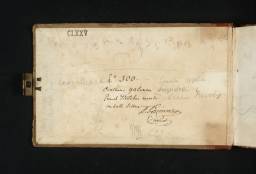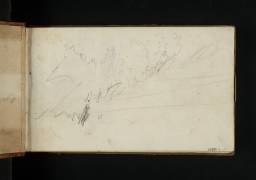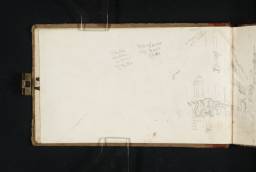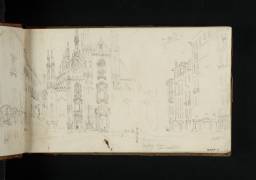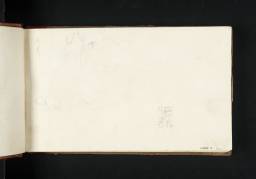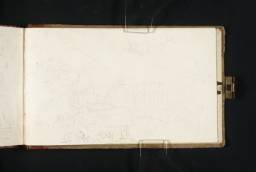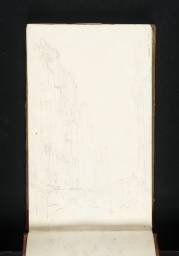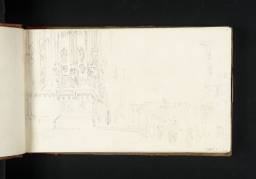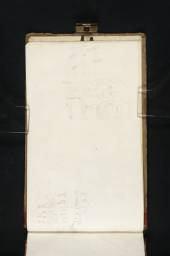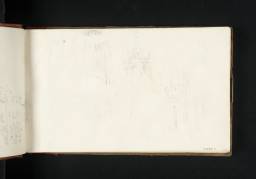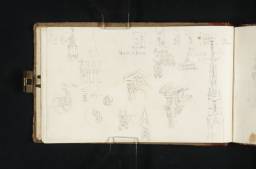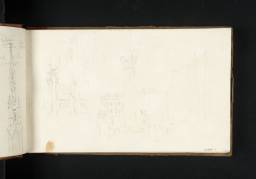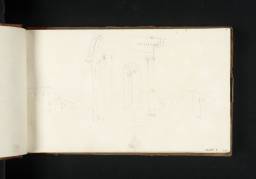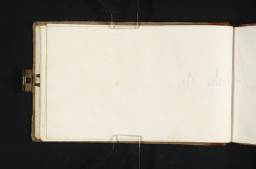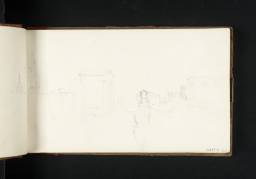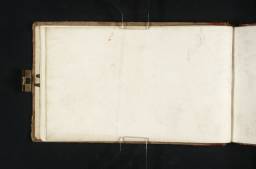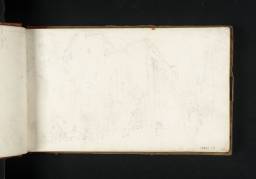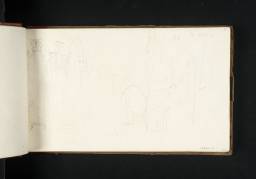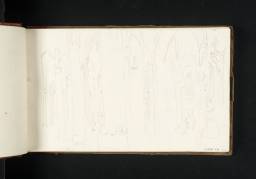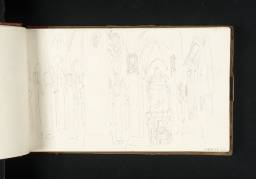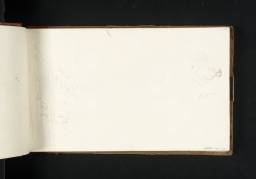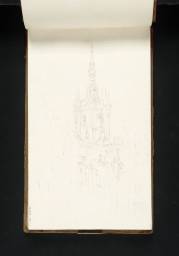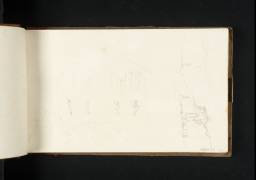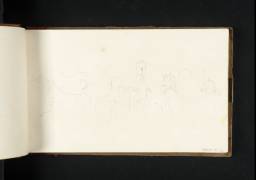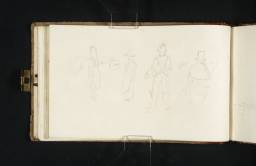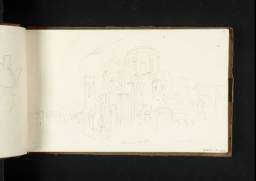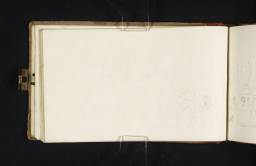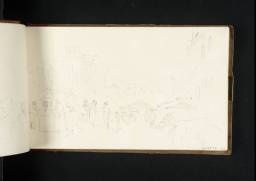Turner Bequest CLXXV 1–90a
Sketchbook, bound in boards, covered in grey paper quarter-bound over brown leather spine; one brass clasp, now missing
91 leaves (including one largely made up with modern paper) and pastedowns of white wove paper, page size 112 x 185 mm; watermark ‘Allee | 1813’; edges washed in yellow
Made by William Allee of Hurstbourne Prior Mill, Hampshire
Inscribed by Turner in ink ‘Milan | to | Venice’ on front cover, top centre and ‘3’ top right (D40890)
Inscribed by Turner in ink ‘3’ on the spine and again on the bottom edge of the page block
Inscribed by Turner in ink ‘Milan to Venice’ on a label on the spine (now lost)
Numbered 300 as part of the Turner Schedule in 1854 and endorsed by the Executors of the Turner Bequest, inside front cover (D40891)
Blind-stamped with Turner Bequest monogram centre left and stamped in black ‘CLXXV’ top right of front cover (D40890)
91 leaves (including one largely made up with modern paper) and pastedowns of white wove paper, page size 112 x 185 mm; watermark ‘Allee | 1813’; edges washed in yellow
Made by William Allee of Hurstbourne Prior Mill, Hampshire
Inscribed by Turner in ink ‘Milan | to | Venice’ on front cover, top centre and ‘3’ top right (D40890)
Inscribed by Turner in ink ‘3’ on the spine and again on the bottom edge of the page block
Inscribed by Turner in ink ‘Milan to Venice’ on a label on the spine (now lost)
Numbered 300 as part of the Turner Schedule in 1854 and endorsed by the Executors of the Turner Bequest, inside front cover (D40891)
Blind-stamped with Turner Bequest monogram centre left and stamped in black ‘CLXXV’ top right of front cover (D40890)
Accepted by the nation as part of the Turner Bequest 1856
Exhibition history
References
This sketchbook records Turner’s straightforward route across north-eastern Italy from Milan to Venice, some 160 miles to the east, in the early stages of his first tour of Italy.
The artist had left England at the beginning of August 1819, with Rome his primary goal. As Nicola Moorby’s overall Introduction to the tour sets out, the phase recorded here had been preceded by arrival by way of the Pass of Mont Cenis and a route through Turin before an extensive diversion north to Lakes Como, Lugano and Maggiore; see the Turin, Como, Lugarno, Maggiore sketchbook (Tate; Turner Bequest CLXXIV). From there Turner made a further detour north-west into Switzerland to see the Simplon Pass, the focus of his Passage of the Simplon sketchbook (Tate; Turner Bequest CXCIV); it is possible that the rough drawings showing lightning on folios 1 recto and 3 verso (D14326, D14330) were made at this time.
Returning past the south-western end of Lake Maggiore, Turner arrived at Milan, where the present book came into use (see under folio 2 recto; D14328). After numerous studies of the city and its cathedral in particular, he travelled east through Brescia (see under folio 19 recto; D14352), Lonato (folio 22 recto; D14357) and Desenzano at the southern end of Lake Garda (folio 21 verso; D14356), and on through the cities of Verona, Vicenza, and Padua (see respectively under folios 25 recto, 32 verso and 35 recto; D14363, D14375, D14380), between which he visited or noted a handful of smaller places (see folios 30 recto, 34 recto and 36 recto; D14371, D14378, D14381).1 The journey from Milan occasioned several typically small but characterful studies of people he travelled with or observed (see under folio 18 verso; D14351), and one or two such more are scattered through the remainder of the book, which concerns the next significant and indeed unique city.
Preceded on folio 37 recto by a study of a local boat (D14383, under which more are noted), and slight drawings on folios 37 verso–39 verso (D14384–D14388), with more attention paid to various small craft than their settings, the remainder of the sketchbook is taken up with views of Venice. The first quarter of a second (Venice to Ancona; Tate; Turner Bequest CLXXVI) contains further pencil drawings of the city, after which Turner used it as he travelled south-west to Bologna, and then south-east to Ancona on the Adriatic coast, before turning inland again towards Rome. He is also generally presumed to have used the larger Como and Venice sketchbook (Tate; Turner Bequest CLXXXI) while at Venice itself, possibly working directly out of doors on a handful of atmospheric and celebrated watercolour studies. The significance of this visit and the city to Turner’s career in general is discussed towards the end of the present sketchbook’s Introduction.
Finberg considered that ‘from the number of sketches he made there’, Turner ‘must have spent a fortnight or more’ in the city,2 but as Ian Warrell has discussed, entries noting arrivals and departures in the Gazzetta Privilegiata di Venezia indicate that ‘Turner William, gent. inglese’ arrived on Wednesday 8 September and left on the following Monday, thus giving him only four full days.3 James Hamilton has suggested from his readings of other entries concerning a possibly misspelt ‘Curner, William’ in the journal, that Turner arrived on 1 September and left on 8 or 9 September,4 giving him a little more time, although this has been disputed.5 He is presumed to have followed advice to stay at a conveniently central hotel, the Albergo Leon Bianco (the Palazzo Cavalli), west of the Rialto Bridge on the Grand Canal; see under folio 49 recto (D14407).6
With more than a third its pages already filled from Milan onwards, the general sequence of this sketchbook, going by the inverted orientation of most of the Venice drawings relative to its subsequent foliation, suggests that Turner began working afresh from the ‘back’. This might indicate that he was moving in systematically from the north-western outskirts down the zigzag reaches of the Grand Canal, to the area around the Salute, Dogana and St Mark’s near its south-east entrance on the Bacino, but there are exceptions, with sketches on the recto and verso being opposite ways up in some cases. There are also numerous studies from out on the open waters of the Bacino and the Giudecca and San Marco canals opening west and east from it.7
As mentioned, Turner is understood to have been based at the heart of the city. Other than noting the clear connection from page to page of some short sequences clustered round key areas, it is perhaps inessential to speculate as to where he began, ended and occasionally digressed.8 Lindsay Stainton has proposed that he ‘could just have done all this ... in a single day, and certainly in two’.9 What is clear is that he packed an enormous amount of intensive and detailed work into the few days he spent in Venice on this first occasion; James Hamilton has perceived ‘a precision and an expansiveness in the drawings in the two Venice sketchbooks that show Turner taking his time, and assuring himself that he would return again and again’,10 while Hardy George has noted that the Venice sketchbook (Tate; Turner Bequest CCCXIV), used on Turner’s next visit in 1833, ‘repeats most of the subjects’ drawn in 1819.11
The main aspects engaging his attention in the present book can be set out as follows, with cross-references to the Venice to Ancona book; later treatments of particular views are discussed in the individual entries. Finberg felt that the ‘sketches in the second book differ somewhat in character from those in the first. They are less obviously made for the purpose of storing information, and are more directly concerned with ideas of future pictures. The difference, however, is slight; it is a matter of degree and of emphasis.’12
Beginning on the margins of the north side of the city, folio 23 recto (D14359), isolated from the main sequence, apparently shows a view along and beyond the quays of the Fondamenta Nuove; see also Tate D14509–D14510 (Turner Bequest CLXXVI 11a–12). Folio 88 recto (D14481; Turner Bequest CLXXV 87) shows a similar prospect inland over the Lagoon from an undetermined viewpoint. Around the north-western entrance to the Grand Canal (near the later railway station) and the Cannaregio Canal come the handful of studies on folios 83 verso, 85 recto (D14475, D14478), 87 recto and verso and 88 verso–89 recto (D14479–D14480, D14482–D14483; Turner Bequest CLXXV 86, 87a–88);13 see also Tate D14513 (CLXXVI 14). East of the Cannaregio there are a few widely dispersed views on the Grand Canal on folios 89 verso–90 recto (D14484; Turner Bequest CLXXV 88a–89), 55 verso and 76 verso–77 recto (D14420, D14461–D14462), while folios 83 verso–84 recto (D14475–D14476) show the prospect as it bears south-east on the approach to the sharp turn towards the Rialto.
The sketches on folios 43 verso, 75 verso, 77 verso and 82a–83 (D14396, D14459, D14463, D14473–D14474) were made at the bend of the Grand Canal just north of the Rialto Bridge; see also Tate D14511–D14512 (Turner Bequest CLXXVI 12a–13). Folio 47 verso (D14404) is a slight view along a narrow street approaching its north end. Views west and north from directly under its single broad span are on folios 80 verso–81 recto and 81 verso–82 recto (D14469–D14472), while there is a close-up study on folios 78 verso–79 recto (D14465–D14466). Looking up and down the bustling stretch centred on his hotel and surveying the canal west of the bridge as far as the entrance to the Rio di San Polo, Turner made the drawings on folios 39 recto, 74 verso–75 recto, 48 verso–49 recto, 79 verso, 73 recto and 74 recto, perhaps on folio 84 verso, and on 72 verso (D14387, D14457–D14458, D14406–D14407, D14467, D14455–D14456, D14477, D14454). He also took a brief excursion down a side canal to explore behind the Palazzo Grimani (folio 90 verso; D14486; Turner Bequest CLXXV 89a).
Turner recorded the bend near the Palazzo Balbi, where the Grand Canal turns out of sight of the Rialto, on folios 71 verso–72 recto (D14452–D14453), and the palace is perhaps shown again on folio 38 recto (D14385). A little further south, towards the next bend south-eastwards towards the Accademia, is the scene on folios 70 verso–71 recto (D14450–D14451). Beside the Accademia itself, where the canal straightens towards its south-eastern entrance, Turner made two drawings looking in that direction (folios 68 verso, 69 verso–70 recto; D14446, D14448–D14449). Further east along this last stretch towards the looming church of Santa Maria della Salute come folios 67 verso and 62 verso (D14444, D14434); from the north side of the canal he made detailed studies of the Salute and the neighbouring Dogana di Mare on folios 54 verso and 40 recto respectively (D14417, D14389), while folios 66 verso–67 recto (D14442–D14443) show a view made in the vicinity, looking across the Bacino to the island and church of San Giorgio Maggiore.
Just to the east, taking in the grand setting and intricate details of the basilica and campanile of San Marco, the Palazzo Ducale (Doge’s Palace) and surrounding buildings, Turner drew in the Piazza San Marco (St Mark’s Square) on folios 41 verso–42 recto, 42 verso, 43 recto and 44 recto (D14392–D14395, D14397; see also Tate D14491 and D14514 (Turner Bequest CLXXVI 2, 14a) and in the adjoining Piazzetta overlooking the Molo and the waters of the Bacino on folios 45 recto, 46 verso–47 recto, 48 recto, 51 verso, 52 recto and verso and 53 verso (D14402–D14403, D14405, D14412–D14414, D14416; see also Tate D14492 (Turner Bequest CLXXVI 3). He also made a quick sketch down a side canal at the back of the Doge’s Palace, with the Bridge of Sighs in the distance, on folio 39 verso (D14388).
Apart from a brief excursion east to the gates of the Arsenale complex (folio 55 recto; D14419), the remainder of the drawings here were made while afloat of the waters south of St Mark’s or overlooking them. Turner looked west across the Bacino from the Canale di San Marco on folios 40 verso, 59 recto and verso and 60 verso–61 recto, and 61 verso–62 recto (D14390, D14427–D14428, D14430–D14433). In the Bacino itself he drew on folios 49 verso, 56 verso, 57 verso, 58 verso, 64 verso–65 recto and 65 verso–66 recto (D14408, D14422, D14424, D14426, D14438–D14441), and made other views across it from off the Isola di San Giorgio Maggiore (folios 50 verso–51 recto, 63 verso–64 recto; D14410–D14411, D14436–D14437). He also ventured a little way west along the Canale di Giudecca south of the Salute and Dogana, as shown on folios 49 verso and 56 verso (D14408, D14422).
The beginning of the Venice to Ancona sketchbook, presumably taken up after this one was filled, is more limited in its coverage of the city; apart from the instances already mentioned, it comprises a short sequence of waterside views from the Molo and the Riva degli Schiavoni and another recording an excursion across the Bacino to the eastern end of the Canale della Giudecca.
In terms of what Turner was expecting from Venice in the context of his wider Italian experience, he had already worked on finished views of the Grand Canal for the architect, artist and author James Hakewill (1778–1843), with whom he had been collaborating on the Picturesque Tour of Italy (published in 1820), interpreting Hakewill’s pencil studies as watercolours for engraving, as discussed in Nicola Moorby’s overall Introduction to the tour; for the two Venice subjects, see under folios 48 verso and 69 verso (D14406, D14448). He knew and admired the works of the great artists of the Venetian School through his studies at the Royal Academy and the Discourses of its President, Joshua Reynolds, examples in British collections and engravings, and his examination of the works of Titian and others gathered at the Louvre in Paris in 1802; see under folio 40 verso (D14390) for studies made in 1819, both here and in the Route to Rome book (Tate; Turner Bequest CLXXI).
Turner spent only a few days in Venice on this occasion, did not return during his 1828–9 Italian tour, and would be there only twice more for fairly short stays in 1833 (less than a fortnight) and 1840 (another fortnight), as addressed in later sections of the present catalogue.14 His intensive topographical sketching in 1819 yielded relatively few immediate results. There were two finished watercolours made for his friend and major patron Walter Fawkes of Farnley Hall in Yorkshire among other Italian scenes:15 The Rialto, Venice (Indianapolis Museum of Art; see under see under folios 73 recto and 74 recto; D14455–D14456);16 and Venice, from Fusina (private collection),17 a distant evocation across the Lagoon rather than a precisely topographical subject, which perhaps hints at his approach in later works more reliant on evocative colour and light than detail.
There is also an unfinished watercolour of a busy scene on The Grand Canal from below the Rialto Bridge, Venice (National Gallery of Ireland, Dublin; see under folios 80 verso–81 recto; D14469–D14470),18 possibly also intended for Fawkes. Turner developed this view in a very large but unfinished painting, The Rialto Venice (Tate N05543),19 likely intended as a companion piece to the identically sized Rome, from the Vatican, exhibited in 1820 (Tate N00503).20 A loosely worked watercolour of distant buildings illuminated by lightning, traditionally known as Catania, Sicily (Museum of Fine Arts, Boston)21 and associated with the mid-1820s ‘Little Liber’ mezzotints (Tate impression: T05202; see the ‘Little Liber 1823–6’ section of this catalogue), may also have Venetian associations.22
A few years later, reflecting the growing popularity among British artists and visitors in the wake of Lord Byron’s poetry, Turner was commissioned to make watercolour vignettes of the city for various literary contexts. Venice, of about 1826–7 (Tate D27710; Turner Bequest CCLXXX 193),23 was engraved in 1830 for Samuel Rogers’s Italy (Tate impression: T04646); see under folio 53 verso (D14416), and the watercolour study, Tate D15258 (Turner Bequest CLXXXI 7), in the Venice and Como book. Venice (The Rialto – Moonlight), of about 1830–2 (Tate D27713; Turner Bequest CCLXXX 196;24 see also D27625; CCLXXX 108),25 was engraved in 1834 for Rogers’s Poems; see under folio 82 verso (D14473). The Bridge of Sighs, Venice (currently untraced)26 was based on a sketch by [?Thomas] Little,27 and engraved in 1832 for Byron’s Life and Works (Tate impression: T06650).
It was not until 1833, just before his second visit, that Turner exhibited his first oil paintings of the city. Bridge of Sighs, Ducal Palace and Custom-House, Venice: Canaletti Painting (Tate N00370)28 acknowledged the importance of Canaletto (1697–1768), whose work was highly regarded by British collectors, as a precursor; again, see under D15258, mentioned above in relation to Rogers’s Italy. A second exhibit, Ducal Palace, Venice,29 is lost, but known from an engraving (Tate impression: T06299).
Venice became an enduring theme in later years, with many watercolours of varying degrees of finish made both for public consumption and Turner’s own more experimental personal purposes, and twenty-three further oils shown at the Academy between 1834 and 1846.30 His topographical and imaginative engagement with the city and the waters surrounding it has been the subject of much subsequent attention, particularly as embodied in the writings of John Ruskin, coloured by teenaged encounters with Turner’s Venice subjects,31 and books by A.J. Finberg,32 Lindsay Stainton,33 Andrew Wilton,34 and Ian Warrell (with other contributors).35 The latter accompanied the major touring exhibition Turner and Venice, originating at Tate Britain in 2003. A touchscreen presentation of the Venice pages of the present sketchbook was featured at the London showing, and in a modified form on the subsequent tour.36
Finberg recorded ‘Turner’s label on back – “Milan to Venice”’,37 presumably in ink on paper on the spine of the book, like those which still survive in other instances such as the consecutive Venice to Ancona sketchbook (Tate; Turner Bequest CLXXVI). Warrell has noted how Turner organised his sketchbooks from the 1819–20 Italian tour with labels and marking ‘the outer edges of the pages of his standard size books with numbers indicating the sequence in which they had been used, suggesting that he perhaps stowed this core group in a box for frequent reference’.38 In this case, ‘3’ appears on the edge of the page block, on the leather spine (presumably hidden by the label Finberg noted), and on the front cover (D40890).39
As quoted and cited individually, the entries here have been informed by extensive manuscript notes by Finberg and C.F. Bell in copies of Finberg’s Inventory held at Tate Britain, transcriptions of Bell’s notes elsewhere by Ian Warrell, and the latter’s own notes in Tate catalogue files.
See Warrell 2003, pp.16, 17, 260 note 18, and Powell in ibid., p.31; see also Powell 1984, p.82, giving Turner’s departure as ‘12 or 13 September’, and p.462 note 61, citing documentation in Hardy George, ‘Turner in Venice’, unpublished Ph.D thesis, Courtauld Institute of Art, University of London 1970, p.65; see also Stainton 1985, p.13 and p.39, citing George, Powell 1987, p.24, Ian Warrell, J.M.W. Turner 1775–1851: Impressions de Gran Bretanya i el Continent Europeu / Impresiones de Gran Bretaña y el Continente Europeo, exhibition catalogue, Centre Cultural de la Fundació la Caixa, Barcelona 1993, p.292, and Ian Warrell, J.M.W. Turner 1775–1851: Aquarelles et Dessins du Legs Turner: Collection de la Tate Gallery, Londres / Watercolours and Drawings from the Turner Bequest: Collection from the Tate Gallery, London, exhibition catalogue, Palais des Beaux-Arts de Charleroi 1994, p.116, and Herrmann 2001, p.359.
See Ian Warrell, ‘The Approach of Night: Turner and La Serenissima’ in Martin Schwander, Bozena Anna Kowalczyk, Warrell and others, Venice: From Canaletto and Turner to Monet, exhibition catalogue, Fondation Beyeler, Riehen 2008, p.67 note 5.
See Finberg 1930, p.20, Stainton 1985, p.13, Warrell 1993, p.292, Warrell 1994, p.116, Warrell 2003, pp.16, 17, and fig.4, where the palazzo is captioned as the hotel in Dionisio Moretti’s 1828 engraving, and Hamilton 2009, p.40.
See Stainton 1985, pp.13–14, for an account based around a core itinerary from north-west to south-east along the canal; see also Butlin and Joll 1984, p.152, and Warrell and Perkins 1988, p.22.
Finberg 1930, p.58, as part of a broader discussion, pp.58, 61; see also pp.19, 21, 22, 163–6, and Finberg 1961, p.261.
See Herrmann 2001, p.360 for possible opportunities in the intervening years, and Powell 2003, pp.30–3 for the itineraries, documentation, dates and duration of the three confirmed visits.
Finberg 1930; including ‘Appendix A: Exhibited Oil Paintings’, pp.155–6, ‘Appendix B: Water-Colours of Venice in Public and Private Collections’, pp.159–62, and ‘Appendix C: Water-Colours and Sketch Books Connected with Turner’s Visits to Venice which Form Part of the Turner Bequest’, pp.163–76, supplementing Finberg’s own 1909 Inventory; for individual watercolours and paintings, see also Wilton 1979 and Butlin and Joll 1984.
Stainton 1985; including a checklist of ‘Paintings of Venetian subjects exhibited by Turner at the Royal Academy 1833–1846’, p.76.
Andrew Wilton, Venise: Aquarelles de Turner, Paris 1995; focusing largely on later works but including three of the 1819 Como and Venice watercolours.
Warrell 2003; including ‘Appendix: The papers used for Turner’s Venetian Watercolours’, pp.258–9, also covering the sketchbooks and thus effectively encompassing all relevant works on paper in the Turner Bequest and elsewhere.
Technical notes
How to cite
Matthew Imms, ‘Milan to Venice Sketchbook 1819’, sketchbook, March 2017, in David Blayney Brown (ed.), J.M.W. Turner: Sketchbooks, Drawings and Watercolours, Tate Research Publication, July 2017, https://www


